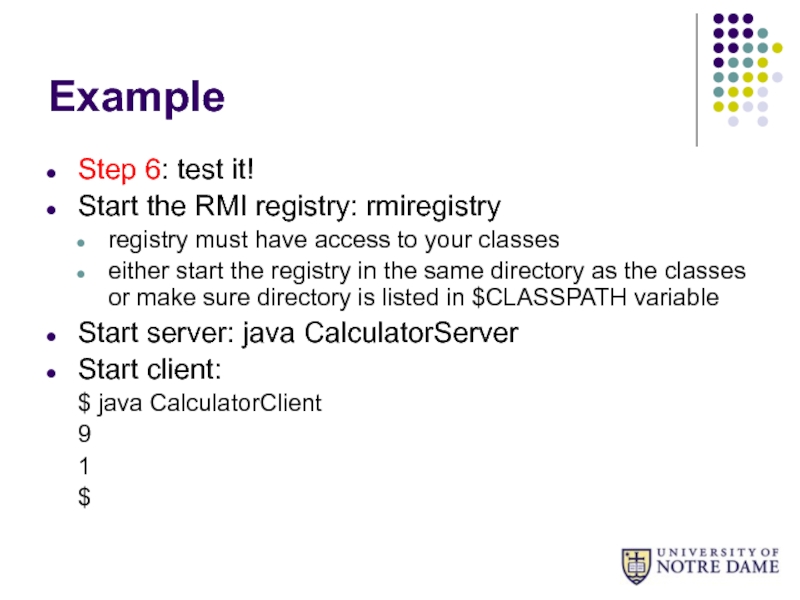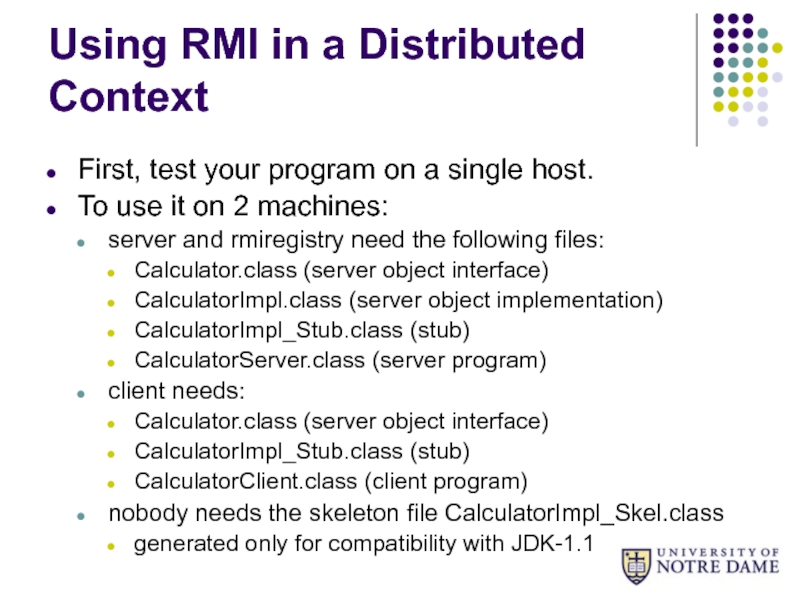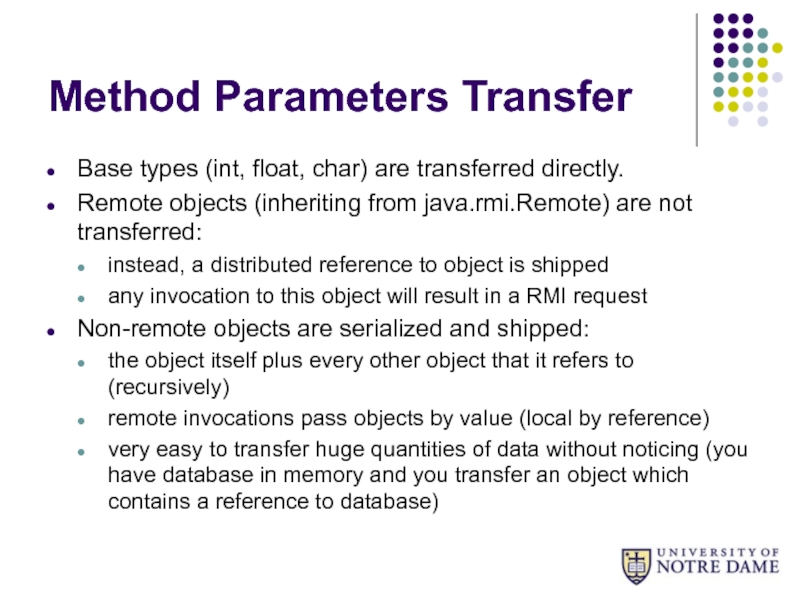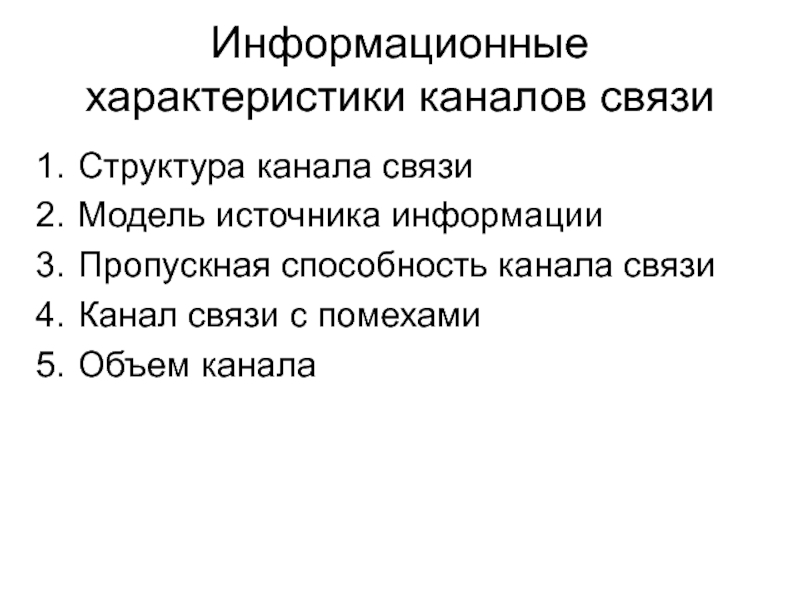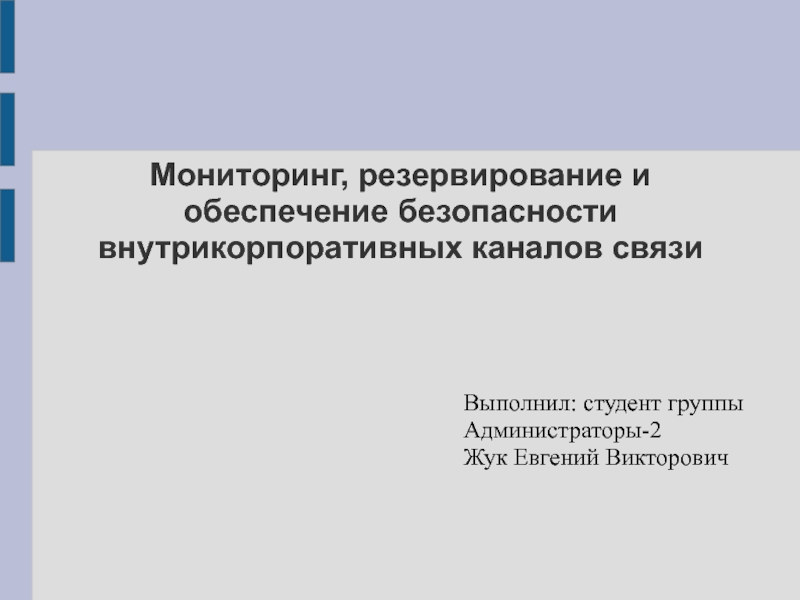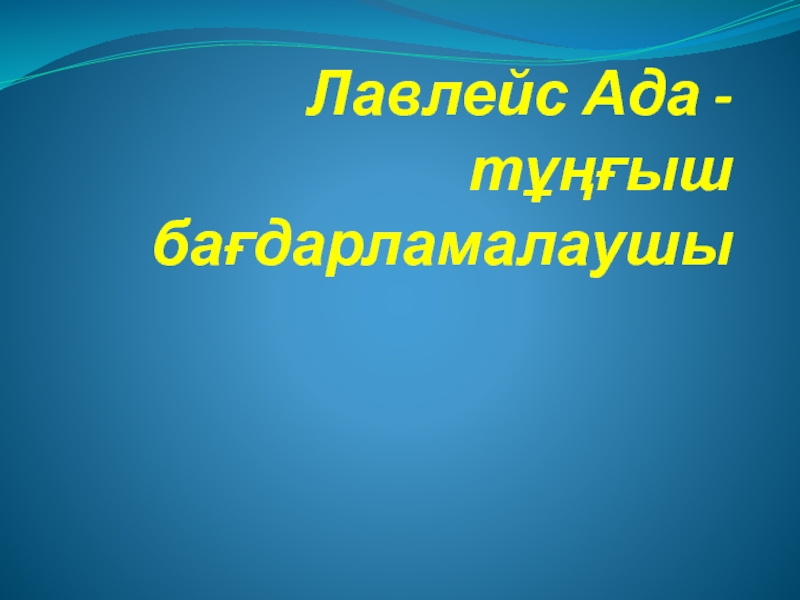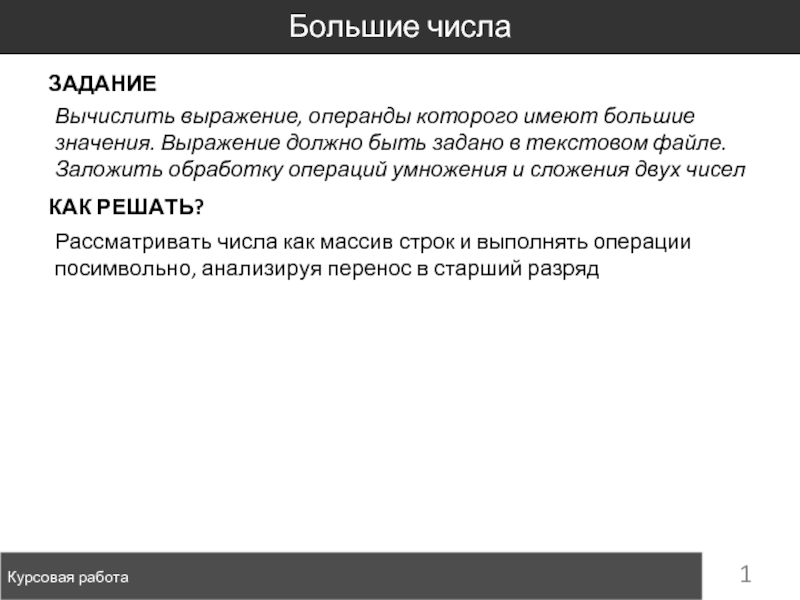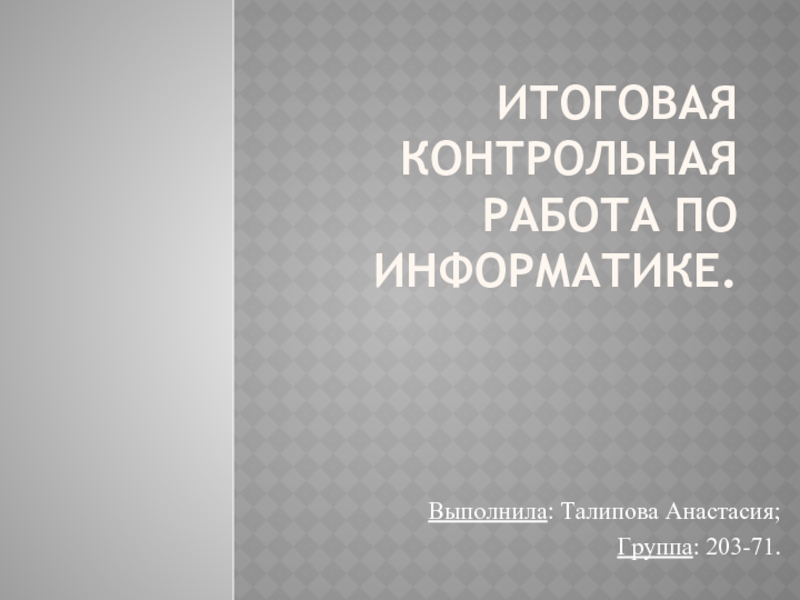of remote objects.
Only between Java programs.
Several versions (JDK-1.1, JDK-1.2)
- Главная
- Разное
- Дизайн
- Бизнес и предпринимательство
- Аналитика
- Образование
- Развлечения
- Красота и здоровье
- Финансы
- Государство
- Путешествия
- Спорт
- Недвижимость
- Армия
- Графика
- Культурология
- Еда и кулинария
- Лингвистика
- Английский язык
- Астрономия
- Алгебра
- Биология
- География
- Детские презентации
- Информатика
- История
- Литература
- Маркетинг
- Математика
- Медицина
- Менеджмент
- Музыка
- МХК
- Немецкий язык
- ОБЖ
- Обществознание
- Окружающий мир
- Педагогика
- Русский язык
- Технология
- Физика
- Философия
- Химия
- Шаблоны, картинки для презентаций
- Экология
- Экономика
- Юриспруденция
Java RMI презентация
Содержание
- 1. Java RMI
- 2. Remote Method Invocation
- 3. Interfaces (Transparency) To client, remote object looks
- 4. RMI Registry RMI needs a port mapper
- 5. Example Simple program: write interface for remote
- 6. Example Step 1: write interface Calculator.java import
- 7. Example Step 2: write remote object CalculatorImpl.java
- 8. Example Implementation class must respect a few
- 9. Example Step 3: generate stub and skeleton
- 10. Example Step 4: write server CalculatorServer.java import
- 11. Example Server program creates CalculatorImpl object. Registers
- 12. Example Step 5: write CalculatorClient.java import java.net.MalformedURLException;
- 13. Example Before invoking the server, the client
- 14. Example Step 6: test it! Start the
- 15. Using RMI in a Distributed Context First,
- 16. Method Parameters Transfer Base types (int, float,
Слайд 2Remote Method Invocation
Client
Server
Client
Remote Object Interface
Stub
Skeleton
Remote Object Interface
Remote Object
Implementation
You implement this
RMI implements
this
Слайд 3Interfaces (Transparency)
To client, remote object looks exactly like a local object
(except that you must bind to it first).
Using interfaces:
you write interface for remote object
you write implementation for remote object
RMI creates stub class (implementing the remote object interface)
client accesses stub exactly same way it would access a local copy of the remote object
Using interfaces:
you write interface for remote object
you write implementation for remote object
RMI creates stub class (implementing the remote object interface)
client accesses stub exactly same way it would access a local copy of the remote object
Слайд 4RMI Registry
RMI needs a port mapper too:
servers can register contact address
information
clients can locate servers
Called RMI registry
You must start it yourself (unlike RPC):
needs to be started on every machine that hosts server objects
program called rmiregistry
runs on port 1099 by default (but you can use ‘rmiregistry’)
Programs can access the registry thanks to java.rmi.Naming class.
clients can locate servers
Called RMI registry
You must start it yourself (unlike RPC):
needs to be started on every machine that hosts server objects
program called rmiregistry
runs on port 1099 by default (but you can use ‘rmiregistry
Programs can access the registry thanks to java.rmi.Naming class.
Слайд 5Example
Simple program:
write interface for remote object: Remote.java
implementation of object: RemoteImpl.java
server to
run object: RemoteServer.java
client to access object: Client.java
RMI compiler ‘rmic’ generates:
client stub: RemoteImpl_Stub.class (already compiled)
server skeleton: RemoteImpl_Skel.class (already compiled)
client to access object: Client.java
RMI compiler ‘rmic’ generates:
client stub: RemoteImpl_Stub.class (already compiled)
server skeleton: RemoteImpl_Skel.class (already compiled)
Слайд 6Example
Step 1: write interface Calculator.java
import java.rmi.Remote;
import java.rmi.RemoteException;
public interface Calculator extends Remote
{
public long add(long a, long b) throws RemoteException;
public long sub(long a, long b) throws RemoteException;
public long mul(long a, long b) throws RemoteException;
public long div(long a, long b) throws RemoteException;
}
Few rules:
interface must extend java.rmi.Remote interface
methods must throw java.rmi.RemoteException exception
Compile:
$ javac Calculator.java
public long add(long a, long b) throws RemoteException;
public long sub(long a, long b) throws RemoteException;
public long mul(long a, long b) throws RemoteException;
public long div(long a, long b) throws RemoteException;
}
Few rules:
interface must extend java.rmi.Remote interface
methods must throw java.rmi.RemoteException exception
Compile:
$ javac Calculator.java
Слайд 7Example
Step 2: write remote object CalculatorImpl.java
import java.rmi.server.UnicastRemoteObject;
import java.rmi.RemoteException;
public class CalculatorImpl extends
UnicastRemoteObject
implements Calculator {
// Implementations must have an explicit constructor
public CalculatorImpl() throws RemoteException {
super();
}
public long add(long a, long b) throws RemoteException {
return a + b;
}
public long sub(long a, long b) throws RemoteException {
return a - b;
}
public long mul(long a, long b) throws RemoteException {
return a * b;
}
public long div(long a, long b) throws RemoteException {
return a / b;
}
}
implements Calculator {
// Implementations must have an explicit constructor
public CalculatorImpl() throws RemoteException {
super();
}
public long add(long a, long b) throws RemoteException {
return a + b;
}
public long sub(long a, long b) throws RemoteException {
return a - b;
}
public long mul(long a, long b) throws RemoteException {
return a * b;
}
public long div(long a, long b) throws RemoteException {
return a / b;
}
}
Слайд 8Example
Implementation class must respect a few constraints:
must implement the interface (of
course)
must inherit from the java.rmi.server.UnicastRemoteObject class
must have explicit constructor which throws the java.rmi.RemoteException exception
Compile:
$ javac CalculatorImpl.java
must inherit from the java.rmi.server.UnicastRemoteObject class
must have explicit constructor which throws the java.rmi.RemoteException exception
Compile:
$ javac CalculatorImpl.java
Слайд 9Example
Step 3: generate stub and skeleton
RMI compiler:
$ rmic CalculatorImpl
Generates CalculatorImpl_Stub.class and
CalculatorImpl_Skel.class files.
Already compiled.
Already compiled.
Слайд 10Example
Step 4: write server CalculatorServer.java
import java.rmi.Naming;
public class CalculatorServer {
public CalculatorServer() {
try
{
Calculator c = new CalculatorImpl();
Naming.rebind(“rmi://localhost:1099/CalculatorService”, c);
} catch (Exception e) {
System.out.println(“Trouble: “ + e);
}
}
public static void main(String args[]) {
new CalculatorServer();
}
}
Calculator c = new CalculatorImpl();
Naming.rebind(“rmi://localhost:1099/CalculatorService”, c);
} catch (Exception e) {
System.out.println(“Trouble: “ + e);
}
}
public static void main(String args[]) {
new CalculatorServer();
}
}
Слайд 11Example
Server program creates CalculatorImpl object.
Registers object to local RMI registry (‘rebind()’):
rebind(String
name, Remote obj) associates a name to an object
names are in the form of a URL:
rmi://[:port]/
Server waits for incoming requests
$ javac CalculatorServer.java
names are in the form of a URL:
rmi://
Server waits for incoming requests
$ javac CalculatorServer.java
Слайд 12Example
Step 5: write CalculatorClient.java
import java.net.MalformedURLException;
public class CalculatorClient {
public static void main(String[]
args) {
try {
Calculator c = (Calculator)
Naming.lookup(“rmi://wizard.cse.nd.edu/CalculatorService”);
System.out.println(c.add(4,5));
System.out.println(c.sub(4,3));
}
catch (Exception e) {
System.out.println(“Received Exception:”);
System.out.println(e);
}
}
}
try {
Calculator c = (Calculator)
Naming.lookup(“rmi://wizard.cse.nd.edu/CalculatorService”);
System.out.println(c.add(4,5));
System.out.println(c.sub(4,3));
}
catch (Exception e) {
System.out.println(“Received Exception:”);
System.out.println(e);
}
}
}
Слайд 13Example
Before invoking the server, the client must ‘lookup’ the registry:
must provide
the URL for remote service
gets back a stub which has exactly the same interface as the server
can use it as a local object: long x = c.add(4,5);
Compile:
$ javac CalculatorClient.java
gets back a stub which has exactly the same interface as the server
can use it as a local object: long x = c.add(4,5);
Compile:
$ javac CalculatorClient.java
Слайд 14Example
Step 6: test it!
Start the RMI registry: rmiregistry
registry must have access
to your classes
either start the registry in the same directory as the classes or make sure directory is listed in $CLASSPATH variable
Start server: java CalculatorServer
Start client:
$ java CalculatorClient
9
1
$
either start the registry in the same directory as the classes or make sure directory is listed in $CLASSPATH variable
Start server: java CalculatorServer
Start client:
$ java CalculatorClient
9
1
$
Слайд 15Using RMI in a Distributed Context
First, test your program on a
single host.
To use it on 2 machines:
server and rmiregistry need the following files:
Calculator.class (server object interface)
CalculatorImpl.class (server object implementation)
CalculatorImpl_Stub.class (stub)
CalculatorServer.class (server program)
client needs:
Calculator.class (server object interface)
CalculatorImpl_Stub.class (stub)
CalculatorClient.class (client program)
nobody needs the skeleton file CalculatorImpl_Skel.class
generated only for compatibility with JDK-1.1
To use it on 2 machines:
server and rmiregistry need the following files:
Calculator.class (server object interface)
CalculatorImpl.class (server object implementation)
CalculatorImpl_Stub.class (stub)
CalculatorServer.class (server program)
client needs:
Calculator.class (server object interface)
CalculatorImpl_Stub.class (stub)
CalculatorClient.class (client program)
nobody needs the skeleton file CalculatorImpl_Skel.class
generated only for compatibility with JDK-1.1
Слайд 16Method Parameters Transfer
Base types (int, float, char) are transferred directly.
Remote objects
(inheriting from java.rmi.Remote) are not transferred:
instead, a distributed reference to object is shipped
any invocation to this object will result in a RMI request
Non-remote objects are serialized and shipped:
the object itself plus every other object that it refers to (recursively)
remote invocations pass objects by value (local by reference)
very easy to transfer huge quantities of data without noticing (you have database in memory and you transfer an object which contains a reference to database)
instead, a distributed reference to object is shipped
any invocation to this object will result in a RMI request
Non-remote objects are serialized and shipped:
the object itself plus every other object that it refers to (recursively)
remote invocations pass objects by value (local by reference)
very easy to transfer huge quantities of data without noticing (you have database in memory and you transfer an object which contains a reference to database)
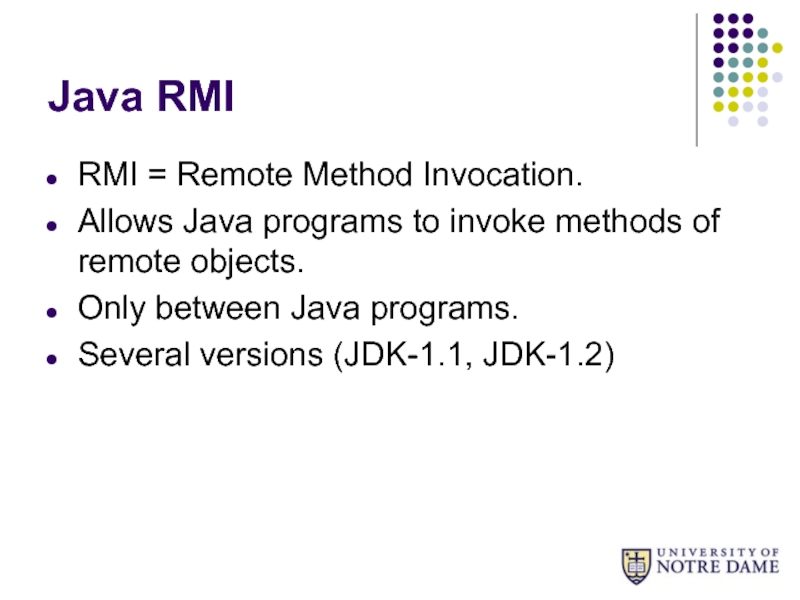
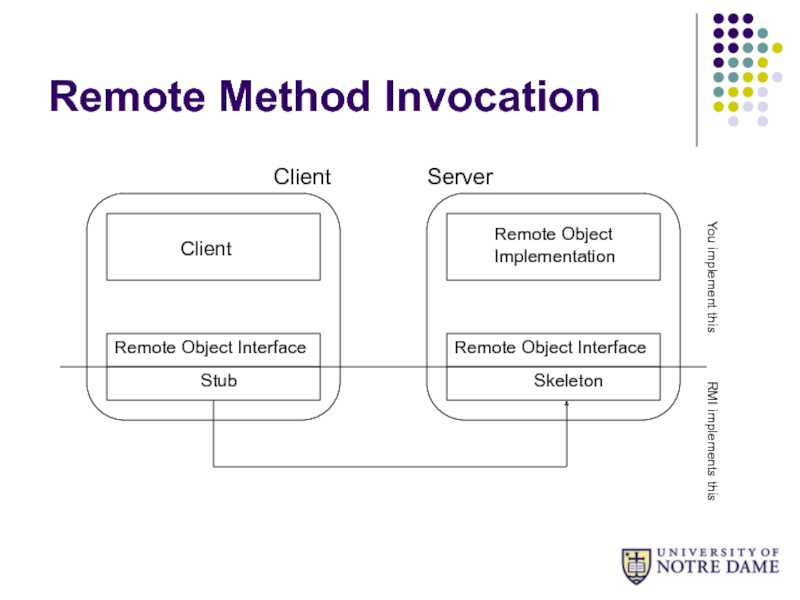
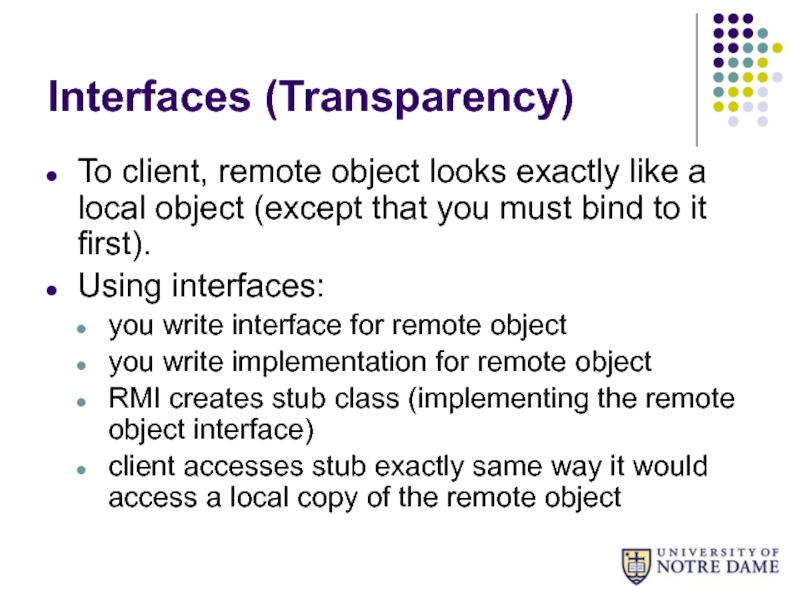


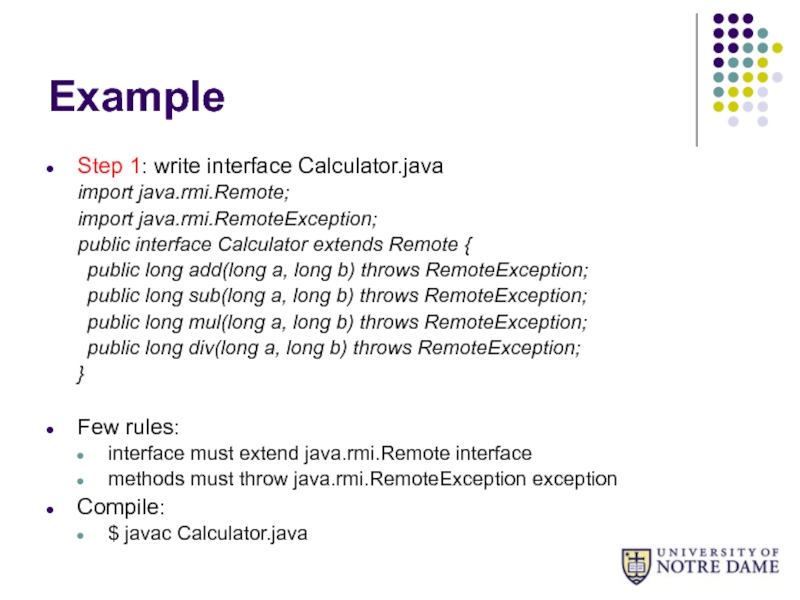
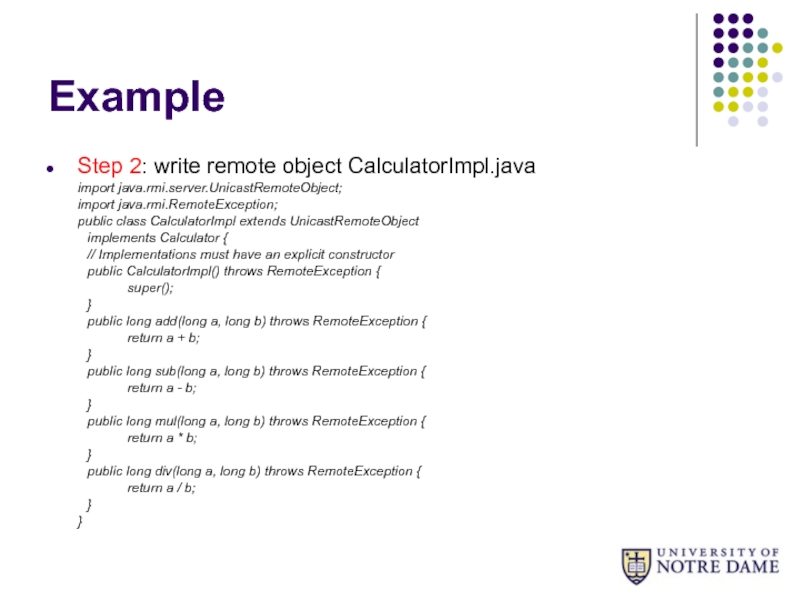
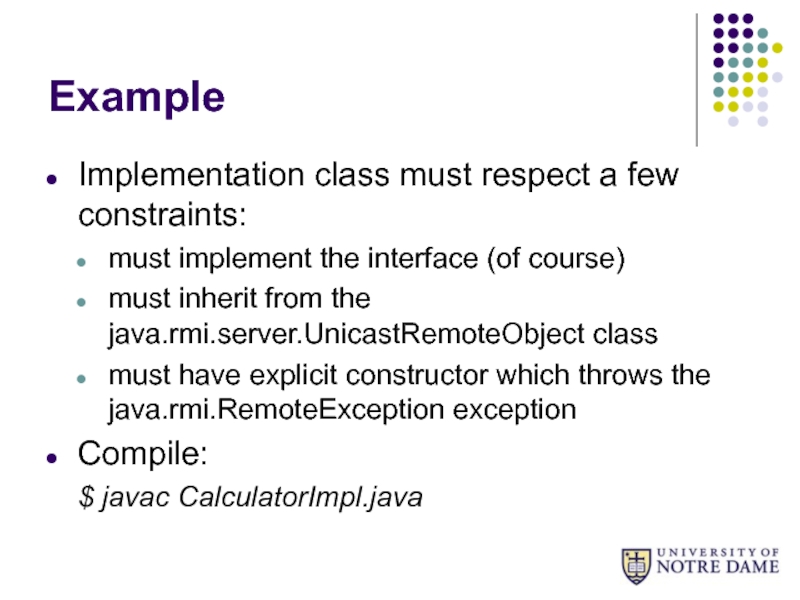
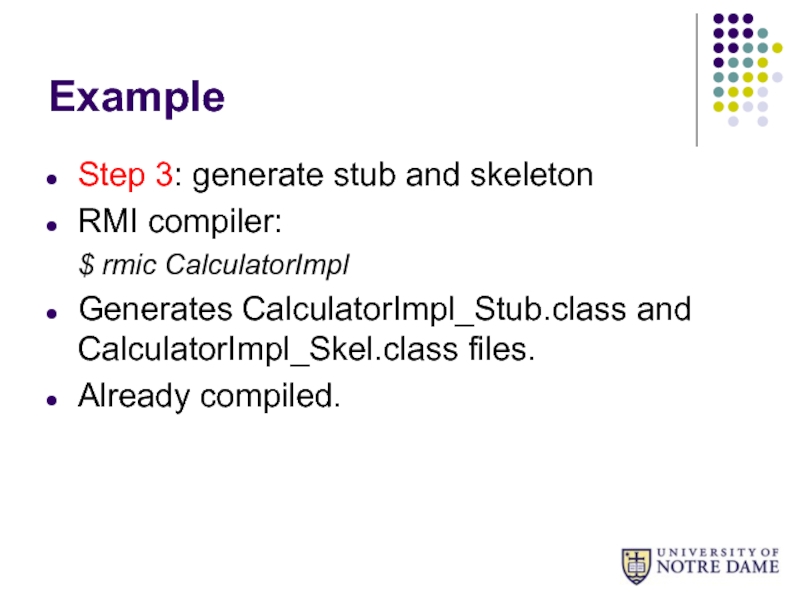
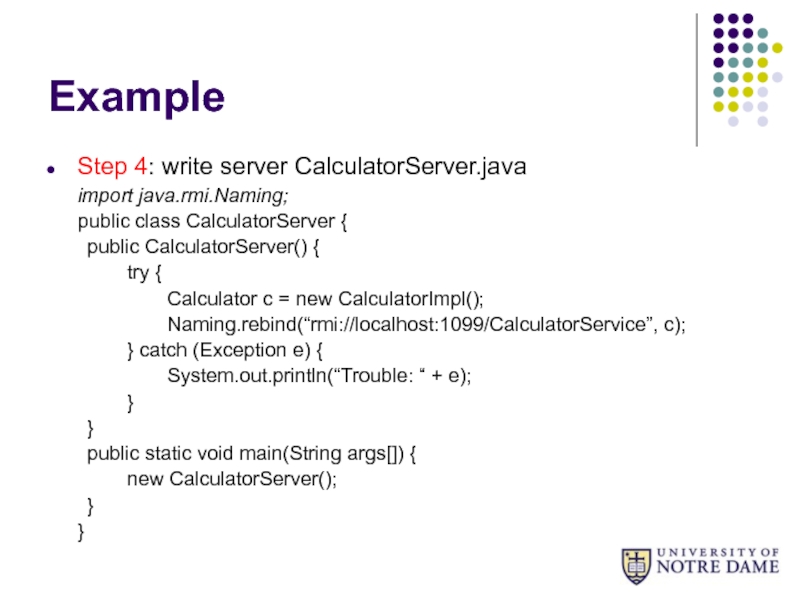
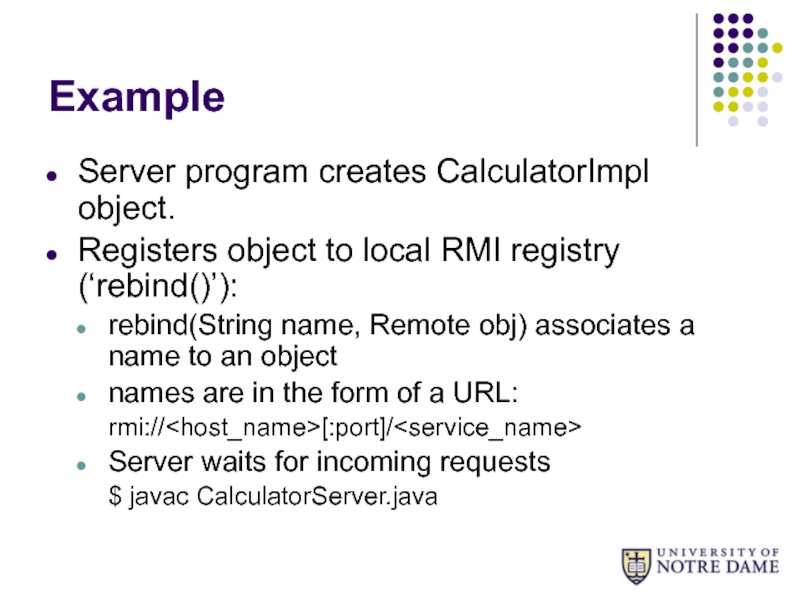
![ExampleStep 5: write CalculatorClient.javaimport java.net.MalformedURLException;public class CalculatorClient { public static void main(String[] args) { try { Calculator c](/img/tmb/4/393328/67f0670de9841cc22fb2743845e7664a-800x.jpg)

